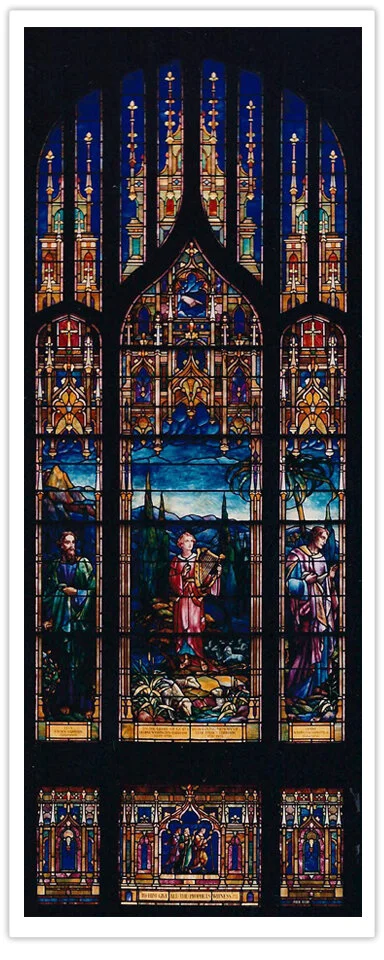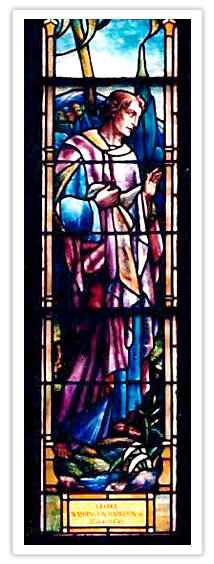
Stained Glass Windows
Law, Psalms, and Prophets
Location
North Wall
Date Installed
June 19, 1938
Executed by
D’Ascenzo
Honoring
George and Lucie Harrison
Illustrating
Exodus 3:1-12; Psalm 23; Isaiah 62:10-12
The scene at the bottom refers back to the preceding window. Dr. Lyons describes this small group of three as “Wise Men - Pilgrims of Night looking towards sunrise.”
The three large panels in the middle (referred to as a trefoil) depict three stories from very different times. They cover a period of about 1,500 years while the world was looking for and waiting for the coming of the Redeemer.
On the left of the trefoil the Law is represented by Moses, perhaps the greatest man of the Old Testament. In the background is Mt. Sinai. Moses has just come down from Mt. Sinai where God spoke to him, giving him the Ten Commandments. At Moses’ feet is the burning bush, the symbol that God is with Moses and that his spirit will be with him all of his life. Moses was very close to God. This great man brought the children of Israel out of Egypt where they had been slaves for 400 years, trained them, developed an army, and formed them into a great nation. All the while this man was staying close to God and trying to lead the people through God’s will.
The larger center panel depicts the Psalms represented by the sweet singer of Israel, David, with his harp. This picture presents David long before he became king. Here he is the shepherd boy. Even in his youth he composed beautiful psalms. At his feet his sheep are drinking from the spring. His shepherd’s crook is lying on the ground in front of his left foot.
The right panel depicts the prophets represented by the prophet Isaiah who throughout his prophecy told about the coming of Jesus Christ. For that reason he was picked from all the prophets to be depicted in the window. Isaiah is not facing toward the other figures in the window. He is looking toward the next window, because Isaiah prophesied more than any other person in the Old Testament, the coming of Jesus Christ.
The small window near the top depicts God’s hand pointing toward the next window, toward the coming of Jesus Christ.
Dr. Lyons’ son commented that Dr. Lyons had a great struggle about having Isaiah turn his back on the rest of the picture, but he could not get away from the necessity of having Isaiah face the future, particularly the Advent.
Great care was taken to match the style and colors of the Tiffany windows. Some who are well experienced with Tiffany’s work can distinguish between the Tiffany and D’Ascenzo windows. For many of us it is easy to imagine that these windows of historic events all came from the same source.


